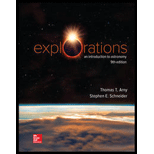
(2.1) List some observational evidence that Earth is round.
The list of some observational evidence that the Earth is round.
Answer to Problem 1QFR
The shadow of Earth’s edge on the Moon during a lunar eclipse and different stars become visible when making travel from north to south.
Explanation of Solution
The following are the observational evidence that the Earth’s is round.
During the lunar eclipse, the edge of the Earth’s shadow on the Moon is always the portion of a circle and that shows the Earth is round.
When we make a journey from north to south, some stars that seen in the north become invisible and some that in the south become visible shows that the Earth is round in shape.
Conclusion:
Therefore, the list of evidence that the Earth is round is given is that the shadow of Earth’s edge on the Moon during a lunar eclipse and different stars become visible when making travel from north to south.
Want to see more full solutions like this?
Chapter 2 Solutions
Loose Leaf For Explorations: Introduction To Astronomy
- Which statement about the dwarf planet Ceres is true? (16.6) (a) It is farthest from the Sun. (b) It is between Mars and Jupiter. (c) It is larger than Pluto. (d) It has a thick atmosphere.arrow_forwardGive four ways to demonstrate that Earth is spherical.arrow_forwardWhich one of the following statements is true? (17.1) (a) The Moons surface gravity is 181 that of the Earth. (b) The Moon has an appreciable magnetic field. (c) The Moon is the second-brightest object in the sky. (d) The Moon revolves around the Earth in 31 days.arrow_forward
- Which of the following statements concerning the terrestrial planets is false? (16.4) (a) Mercury and Venus can never be in opposition. (b) All have magnetic fields except Venus. (c) All rotate clockwise as viewed from above the North Pole. (d) They are relatively close to the Sun.arrow_forwardSaturn has an angular size of 16”, and an observed Synodic Period of 1.035yrs. Saturn’s moon, Titan orbits the planet with an angular separation of 192”, with a period of 15.9days. From these observations we can determine Saturn’s mass. Use the Sidereal Period of Saturn above to find the distance to Saturn from the Sun.arrow_forwardWhat is a revolution? Can you give an example?arrow_forward
- The Earth has a mass of 5.97 * 1024 kg and the Moon has a mass of 7.35 * 1022 kg. If they are separated by a distance of 3.85 * 105km, what is the force (in N) between the Earth and the Moon? (Enter your answer in scientific notation: 1.23E12 means 1.23 * 1012)arrow_forwardIf Earth rotated once every 48 hours, and everything else was the same, which of the following statements would not be true? High tide would happen less frequently. The length of a day would be longer. The length of the year would be longer. The daytime temperatures would be higher on average. There would still be summer and winter in the temperature zones.arrow_forwardGiven that Earth is about 4.6 billion (4.6 x 10%) years old, how many precessional cycles have occurred?arrow_forward
- The Earth has a mass of 5.97 * 1024 kg and the Moon has a mass of 7.35 * 1022 kg. If they are separated by a distance of 3.85 * 105 km, what is the force (in N) between the Earth and the Moon? (Enter your answer in scientific notation: 1.23E12 means 1.23 * 1012)arrow_forwardOn the evening of an autumnal equinox day Siddhant noticed that Mars was exactly along the north-south meridian in his sky at the exact moment when the sun was setting. In other words, the Sun and Mars subtended an angle of exactly 90° as measured from the Earth. If the orbital radius of Mars is 1.52 au, What will be the approximate rise time of the mars on the next autumnal equinox day?arrow_forward(to two decimal places): (what is ‘h’?) Eccentricity of earth orbit is 0.0167 µ(sun) = 1.32712E+11 km^3/s^ semimajor axis of Earth orbit = 1.49598E+08 need to figure out what ‘h’ is. a) Calculate the speed of the earth around the sun at aphelion? (29.29 KM/S) b) At perihelion? (30.29 KM/S)arrow_forward
 An Introduction to Physical SciencePhysicsISBN:9781305079137Author:James Shipman, Jerry D. Wilson, Charles A. Higgins, Omar TorresPublisher:Cengage Learning
An Introduction to Physical SciencePhysicsISBN:9781305079137Author:James Shipman, Jerry D. Wilson, Charles A. Higgins, Omar TorresPublisher:Cengage Learning AstronomyPhysicsISBN:9781938168284Author:Andrew Fraknoi; David Morrison; Sidney C. WolffPublisher:OpenStax
AstronomyPhysicsISBN:9781938168284Author:Andrew Fraknoi; David Morrison; Sidney C. WolffPublisher:OpenStax Stars and GalaxiesPhysicsISBN:9781305120785Author:Michael A. Seeds, Dana BackmanPublisher:Cengage Learning
Stars and GalaxiesPhysicsISBN:9781305120785Author:Michael A. Seeds, Dana BackmanPublisher:Cengage Learning



